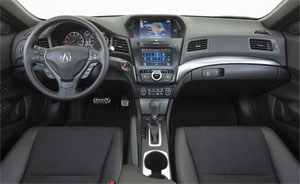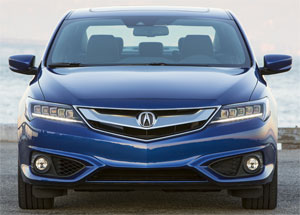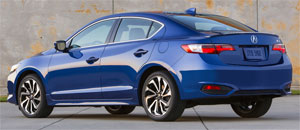2016 Acura ILX
When the Acura ILX arrived for 2013, even we had a hard time not dwelling too much on its civic-minded origins. Fortunately for Acura, the ILX did appeal to buyers; more importantly, to that holy grail of demographics, elusive younger buyers. So, let’s see if that group might find a new ILX even more appealing.
While the 2016 Acura ILX is not all-new, as far as mid-cycle re-freshing goes, this one is quite thorough.
Now assembled in Honda’s Marysville, Ohio plant right alongside the recently introduced mid-size TLX. And, much like it, the compact ILX takes the majority of its design cues from Acura’s flagship RLX, yet also adds enough sporty elements to keep those 20 and 30-somethings interested.
So understandably Acura’s Jewel-Eye headlights are now standard; as well as an aggressive looking front fascia with large air intakes down below.
ILX wheelbase is unchanged at 105.1-inches, as are most exterior dimensions, save for overall length which grows by almost 3-inches. A-SPEC trim adds a rear spoiler, sweet-looking 10-spoke 18-inch machined-finished alloy wheels with 225/40 tires, fog lights, and some tacked-on rocker trim.
 Inside, it augments the seats with Luxe-suede coverings, and adds sport pedals to what has become a very roomy and increasingly premium feeling interior. Other highlights include adopting the familiar Honda/Acura dual screen center stack, and making a multitude of additional AcuraWatch radar and camera-based safety systems, like Collision Mitigation and Lane Keeping, available.
Inside, it augments the seats with Luxe-suede coverings, and adds sport pedals to what has become a very roomy and increasingly premium feeling interior. Other highlights include adopting the familiar Honda/Acura dual screen center stack, and making a multitude of additional AcuraWatch radar and camera-based safety systems, like Collision Mitigation and Lane Keeping, available.
Push button ignition and a Multi-View rear camera are standard. The Tech Plus package adds navigation with AcuraLink, as well as a color Multi-Information Display in the sporty looking gauge panel and 415-watt ELS premium audio with 10-speakers.
The front seating area is indeed spacious, and surprisingly luxurious in feel; very reminiscent of the TLX and RLX. The seats are quite comfortable in back as well; but head and knee room are both insufficient for full-size adults. Cargo space is unchanged at 12.3 cubic-ft. and the area is well-finished.
A folding rear seatback is standard, but it’s a single piece, not split; and the only release is located in the trunk. It’s probably the only remaining real reminder of this ride’s economy car roots.
Perhaps because of the shorter attention span of all of those younger buyers, engine options have been simplified; with now just a 2.4-liter I4 available. The direct-injected piece outputs 201–horsepower and 180 lb-ft. of torque. Gone, are the base 2.0-liter I4 and, at least for now, the ILX Hybrid.
 Attached to the 2.4 is an 8-speed DCT, but unlike most dual-clutch units; there’s a slushbox-style torque converter to maintain the feel of a traditional automatic, particularly when accelerating from a stop.
Attached to the 2.4 is an 8-speed DCT, but unlike most dual-clutch units; there’s a slushbox-style torque converter to maintain the feel of a traditional automatic, particularly when accelerating from a stop.
Most of our drivers had good things to say about the trans, and the overall surprisingly sporty driving experience as well; though like many 8-speeds, it can at times be in a hurry to find higher gears.
Of course you can learn a lot more about a car on the track, and here we were equally impressed with how nicely the ILX handled our slalom test. Accurate turn-ins without a peep of understeer, and a well-balanced chassis had us scooting through the cones with ease.
The body structure has been stiffened; and the MacPherson strut front, multi-link rear suspension re-tuned.
But, there’s not really enough power to get you into too much trouble; as we found out when doing straight-line runs.
It took us a leisurely - for a sporty sedan - 7.1-seconds to hit 60, and 14.7 to finish out the ¼ at 93 miles-per-hour. There was zero torque steer at launch, and not a lot of grunt either. But the engine does rev quickly, and like most 4’s pulls strongest in the upper rev ranges. Shifts were quick and firm.
 Braking from 60 averaged a good 121-feet. Stability was excellent and fade minimal.
Braking from 60 averaged a good 121-feet. Stability was excellent and fade minimal.
Government Fuel Economy Ratings are 25-City, 36-Highway, and 29-Combined. We averaged a very good 31.6 miles-per-gallon on Premium fuel. So, the Energy Impact Score is much better than average with 11.4-barrels of oil ingested yearly, while expelling 5.0-tons of CO2.
Pricing for the ILX starts at a very sensible $28,820. And even the top line A-SPECs starts at just $35,810.
It’s an unfortunate truism that the more successful you become, the harder it is to become more successful. But we think Acura is certainly heading in a great direction now. And injecting the 2016 Acura ILX with both more performance and more prestige will ensure that it not only stays appealing to those hip, young trendsetters, but it will become a whole lot more appealing to a broader spectrum of sport-luxury sedan buyers.
Specifications
- Engine: 2.4 liter
- Horsepower: 201
- Torque: 180 lb-ft.
- 0-60 mph: 7.1 seconds
- 1/4 mile: 14.7 seconds @ 93 mph
- EPA: 25 mpg city/ 36 mpg highway
- Energy Impact: 11.4 barrels of oil/yr
- CO2 Emissions: 5.0 tons/yr
2024 Polestar 2
More Range And More Power For The Polestar 2
Volvo is well on their way to making the transition to an all-electric brand, but their sister-brand Polestar is already there. Now, we’ve spent lots of time in their all-wheel drive, five-door Polestar 2, having tested it in 2021, and a year later when a two-wheel drive version arrived. But, EV updates are coming quickly. So, let us be your guide for all that’s new with the Polestar 2.
While we are driving more EVs than ever, we’ve also been spending a lot of time recently circling back to ones we’ve previously tested. As in this new era of electrified vehicles, significant updates are arriving quickly, with R&D investments increasing and retrofitting them easier than ever. This is often done through software updates that can even be accomplished over the air. For 2024, the Polestar 2 has indeed gotten some software updates, but some physical ones as well.
Clearly aimed directly at Tesla’s Model 3 when it arrived; the Polestar 2’s build quality was vastly better, but range definitely came up short. So, addressing that was priority No. 1; and for ’24 the Polestar can travel up to 20% farther than before while consuming 9% less energy, and when it comes time to charge it back up, it can do that 34% faster too.
Range in the Single Motor version increases from a max of 270 to 320 miles thanks to a larger 82-kWh battery pack, and that solitary motor now powers the rear wheels, not the front wheels. It’s also bigger, coming in at 220 kW compared to the previous 170 kW front-wheel drive version, going from 231 to 299 horsepower.
Dual Motors keep the same 78-kWh battery, but still sees a boost from 260 to 276 miles and takes advantage of the larger rear motor for a new combined 310-kW output with 421 horsepower. Our test car has the added Performance Pack, which uses an additional 35 kW to deliver 455 horsepower and 546 lb-ft of torque, though max range drops to just 247 miles.
The new battery in rear-drive 2s will also charge faster, now accepting up to 205 kW for an 80% charge in 20 minutes; max for dual-motors stays at 155 kW, which puts an 80% charge at 34 minutes. Using 32 kWh of electricity per 100 miles, the Dual Motor earns a good efficiency rating.
The [Polestar] 2 has always been one of the most enjoyable EVs to drive, even more so now with that additional power coming from the rear motor.
Unfortunately, extremely cold temperatures kept us from seeing that increased range, as we were only on pace for about 194 miles in our test.
The 2 has always been one of the most enjoyable EVs to drive, even more so now with that additional power coming from the rear motor. And especially when equipped with the Performance Pack as it not only includes more power, but adds 20-inch forged wheels, upgraded brakes, and adjustable Ohlins Dual Flow Valve performance dampers. It greatly improves handling prowess without affecting ride quality, and is easily worth the $5,500 charge if you at all enjoy driving.
Even on a 20-degree track day there was plenty of grip through our handling course. No understeer or oversteer, and lots of feedback through the wheel. There was a nice, strong launch off the line that properly planted us firmly in the seat, and rocketed us to 60 in 4.5 seconds. Power delivery stayed pretty intense up until about 80 mph when there was a definite tapering off. Still, it was a 13.4-second quarter-mile at 102 mph; smooth, quiet, and stable the whole way.
When this car debuted, its Google-based infotainment setup was a novelty, but since then, more and more manufacturers are just “Googling it” so it doesn’t seem out of place at all. The wireless phone charger is easy to access, and there’s a great Harmon/Kardon sound system and panoramic sunroof to enhance the in-cabin experience. Exteriors have also been enhanced with a smooth grille insert and new wheel choices.
Hatchback practicality means 14.3 cu-ft of easy to access cargo space with split-folding seatbacks for longer items and expanding the space to 38.7 cu-ft. Plus, there’s even a sizeable storage bin up front under the hood.
Single Motor Polestar 2 pricing now starts at $51,300, with Dual Motors starting at $56,700; topping out at $64,400.
For a car manufacturer that hasn’t even been around for a decade yet, Polestar has kept itself busy, totally transforming their latest model in just a few years, making the 2024 Polestar 2 even more appealing. They are certainly off to a good start, and with a host of Polestars just over the horizon, including some all-important utility vehicles, this star will be shining even brighter.
Specifications
As Tested
- Motor Setup: Dual Motor
- Horsepower: 455
- 0-60 mph: 4.5 seconds
- EPA Range: 247 miles
- Efficiency : 32 kWh / 100 miles
- Battery Size: 78-kWh
- Torque: 546 lb-ft
- 1/4 Mile: 13.4 seconds at 102 mph
- MW Test Loop: ~ 194 miles
- Peak Charging Rate: 155 kW











































